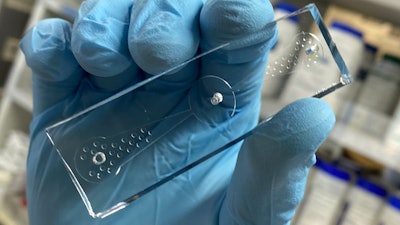
Dogs can use their incredible sense of smell to sniff out various forms of cancer in human breath, blood and urine samples. Similarly, in the lab a much simpler organism, the roundworm C. elegans, wriggles its way toward cancer cells by following an odor trail. Today, scientists report a device that uses the tiny worms to detect lung cancer cells. This “worm-on-a-chip” could someday help doctors noninvasively diagnose cancer at an earlier stage.
The researchers will present their results at the spring meeting of the American Chemical Society (ACS). ACS Spring 2022 is a hybrid meeting being held virtually and in-person March 20-24, with on-demand access available March 21-April 8. The meeting features more than 12,000 presentations on a wide range of science topics.
Early diagnosis of cancer is critical for effective treatment and survival, says Nari Jang, a graduate student who is presenting the work at the meeting. Therefore, cancer screening methods should be quick, easy, economical and noninvasive. Currently, doctors diagnose lung cancer by imaging tests or biopsies, but these methods often can’t detect tumors at their earliest stages. Although dogs can be trained to sniff out human cancer, they aren’t practical to keep in labs. So Jang and Shin Sik Choi, Ph.D., the project’s principal investigator, decided to use worms called nematodes, which are tiny (~1 mm in length), easy to grow in the lab and have an extraordinary sense of smell, to develop a noninvasive cancer diagnostic test.
“Lung cancer cells produce a different set of odor molecules than normal cells,” says Choi, who is at Myongji University in Korea. “It’s well known that the soil-dwelling nematode, C. elegans, is attracted or repelled by certain odors, so we came up with an idea that the roundworm could be used to detect lung cancer.” Other researchers have placed nematodes in petri dishes and added drops of human urine, observing that the worms preferentially crawled toward urine samples from cancer patients. Jang and Choi wanted to make an accurate, easy-to-measure form of the test.
So the team made a chip out of polydimethylsiloxane elastomer that had a well at each end connected by channels to a central chamber. The researchers placed the chip on an agar plate. At one end of the chip, they added a drop of culture media from lung cancer cells, and at the other end, they added media from normal lung fibroblasts. They placed worms in the central chamber, and after an hour, they observed that more worms had crawled toward the lung cancer media than the normal media. In contrast, worms that had a mutated odor receptor gene called odr-3 did not show this preferential behavior.
Based on these tests, the researchers estimated that the device was about 70% effective at detecting cancer cells in diluted cell culture media. They hope to increase both the accuracy and sensitivity of the method by using worms that were previously exposed to cancer cell media and therefore have a “memory” of cancer-specific odor molecules. Once the team has optimized the worm-on-a-chip for detecting cultured lung cancer cells, they plan to move on to testing urine, saliva or even exhaled breath from people. “We will collaborate with medical doctors to find out whether our methods can detect lung cancer in patients at an early stage,” Choi says. They also plan to test the device on multiple forms of cancer.
In other studies using the worm-on-a-chip, the researchers identified the specific odor molecules that attract C. elegans to lung cancer cells, including a volatile organic compound called 2-ethyl-1-hexanol, which has a floral scent. “We don’t know why C. elegans are attracted to lung cancer tissues or 2-ethyl-1-hexanol, but we guess that the odors are similar to the scents from their favorite foods,” Jang says.
The researchers acknowledge support and funding from the National Research Foundation of Korea.
ACS Spring 2022 will be a vaccination-required and mask-recommended event for all attendees, exhibitors, vendors, and ACS staff who plan to participate in-person in San Diego, CA. For detailed information about the requirement and all ACS safety measures, please visit the ACS website.






















